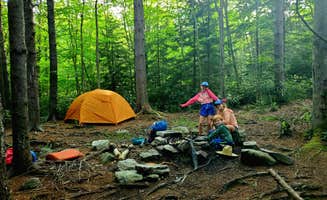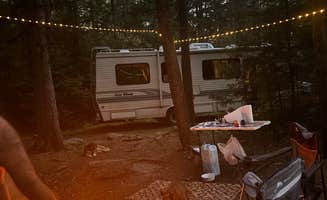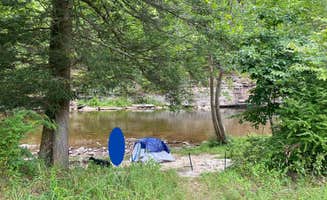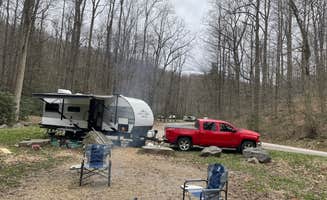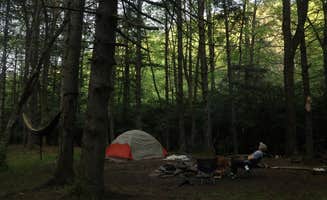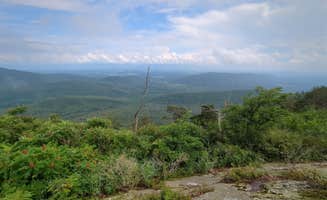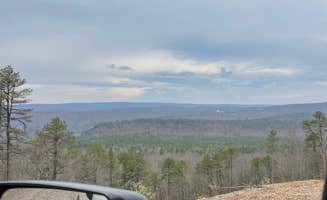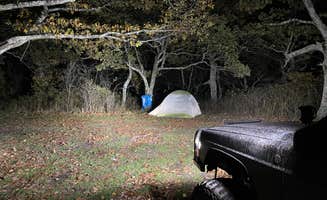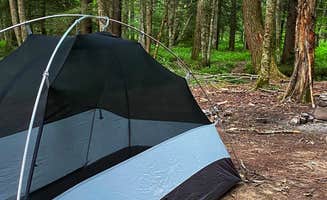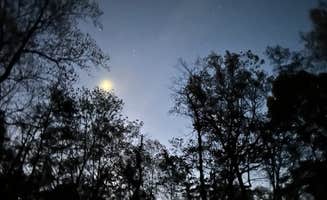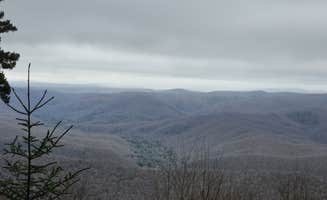Primitive camping near Cabins, West Virginia offers wilderness experiences across high-elevation terrain ranging from 2,000 to 4,000 feet. The region experiences variable weather patterns with temperature fluctuations of 30°F possible within a single day, especially at higher elevations where conditions often mimic northern climates. Most backcountry sites require significant preparation as forest access roads remain unpaved and frequently deteriorate during spring melt or following heavy rainfall.
What to do
Hiking and photography trails: Numerous trails through Monongahela National Forest provide access to primitive camping areas. According to one backpacker at Dolly Sods Backcountry, "We hiked in in warm weather and once we reached the top of a long entrance road (where one trailhead was) we found snow. A lot of the snow had melted making the ground very soggy and oversaturated in some areas."
Fishing in creek-side spots: The forest streams near many primitive sites support trout fishing. A visitor to Gandy Creek Dispersed Camping notes, "Very nice area several nice spot right along the creek. Areas are spread out and private. Nice spot to relax and escape along creek. Drive back is well maintained dirt road."
Stargazing from open clearings: Several primitive sites offer unobstructed night sky views. One camper at Gandy Creek observed, "We were lucky enough to get a site next to the river! Get there early as it's first come first serve! That being said just park somewhere and walk 300' from the road!"
What campers like
Unique ecosystems: Many primitive campers appreciate the diverse environments. A visitor to Wolf Gap Recreation Area noted, "The campground has vaulted toilet and communal garbage receptical. There is a large day use area. There are several trails that intersect with the campsite and day hikers are a common site."
Privacy between sites: Dispersed camping areas typically offer good separation between campsites. At Gandy Creek, one camper reported, "These sites take a while to get to but they are awesome. Each site is secluded and creek front. We stayed at the last site with the cliff over hang and it was magical."
Multi-day backpacking options: The interconnected trail systems allow for extended trips. One backpacker at Dolly Sods shared, "Did a four-day hike of the 26-mile loop in Dolly Sods Wilderness, first night we camped was at Ravens Ridge. There were some camps already in that area but in the woods, however we chose to set up camp on the ridge with a view of Canaan Valley."
What you should know
Vehicle clearance requirements: Forest roads to many primitive sites require appropriate vehicles. A visitor to Switzer Lake Dispersed Camping advised, "Once you turn onto Switzer Lake Rd from U.S. 33 and find the parking area to the lake on your left, be prepared to drive another 2ish miles on a single lane and very bumpy dirt road. Go slow as several sharp corners with huge drops and inexperienced drives coming towards you."
Seasonal conditions: Weather variability affects camping conditions significantly. A Dolly Sods visitor shared, "Know that it will likely rain on you in Dolly Sods, so always bring rain gear. Also realize, that with climate and conditions similar to the Canadian Tundra, temperatures and winds vary and fluctuate often, any time of year."
Wildlife precautions: Proper food storage is essential in this bear country. "There are bears here, so lock up your food in the car. We have encountered a bear at or around the campsite 3 times," reported one camper from Switzer Lake.
Tips for camping with families
Site selection strategy: Choose established sites with natural features for family activities. A visitor to Canaan Loop Road Dispersed noted, "We arrived in the late afternoon and found a very pleasant back-in spot about a mile or so in. Hiked a few of the nearby trails. Saw some bear scat, but past that the only animals we saw were a few frogs."
Weather preparation: Pack for temperature extremes regardless of season. One family camping at Dolly Sods advised, "Definitely be prepared for high winds and rain. We hiked in in warm weather and once we reached the top of a long entrance road (where one trailhead was) we found snow."
Navigation essentials: Bring physical maps and compasses for all family members. A Dolly Sods camper emphasized, "A good physical map and compass, the skills needed to use them, are vital here. There are no trail marks and the path can be confusing. Come prepared and have a great adventure."
Tips from RVers
Access road assessment: Scout roads before attempting access with trailers or larger vehicles. At Lower Glady Dispersed Campground, a camper noted, "There is a very sharp turn if you come in from the south on Sully Road, which seems to be the primary way to get there. My Subaru Forester didn't have any issues, but if you're driving an RV or have a trailer, you may have a struggle."
Limited turnaround areas: Research designated RV-accessible sites beforehand. One RVer reported about Lower Glady, "We pulled our 28 foot travel trailer in past I'd say ten other campsites that were taken. The last big turnaround featured four rv accessible campfires for us to pick."
Early arrival importance: Many RV-suitable primitive sites fill quickly. "We tried to get a spot this weekend and arrived around 430pm on Friday. Every single spot was taken with many people who look like they have been set up there all summer," warned a visitor to Lower Glady.


